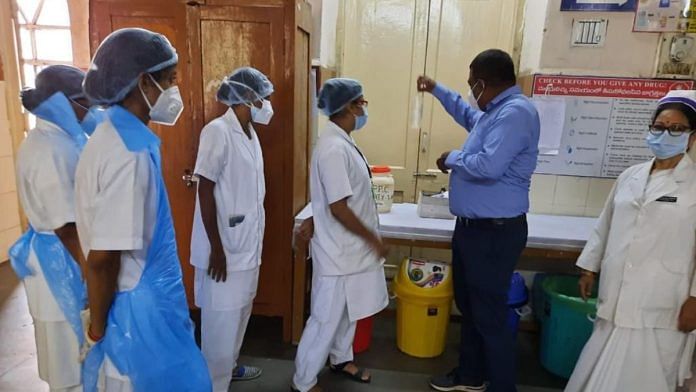New Delhi: The National Essential Diagnostics List (NEDL)—which consists of the minimum number of tests that must be available at all government-run health facilities—is set to be expanded this year, with the aim of providing testing facilities to patients near their homes.
The Indian Council of Medical Research (ICMR) released the draft NEDL 2025 Thursday, asking for public comments and feedback before it is notified.
According to the proposed NEDL, Ayushman Arogya Mandirs—previously known as health sub-centres—should provide 16 types of diagnostic tests instead of 12 as prescribed in NEDL 2019, which is currently in practice.
The first-ever NEDL was notified in 2019 in order to make diagnostic services an essential component of the public healthcare system.
At primary health centres (PHCs), on the other hand, the number of essential tests has been proposed to be 74 instead of 64. Meanwhile, at community health centres (CHCs), the number of the tests that must be available is 93, compared to the current 70.
The maximum increase, however, has been proposed at district hospitals, which have been asked to provide 171 tests instead of 117.
Additionally, the number of tests conducted at village levels, mostly by accredited social health activists (ASHAs) will now be 9 instead of 6.
The apex health research agency has also clarified that while samples for various tests will be collected at each level, actual tests will be conducted through a hub-and-spoke model at centres where testing facilities are available.
“The revised NEDL takes into account the guidance documents released by the Union health ministry and aligns with national health programmes. It significantly builds upon the first list and provides recommendations for diagnostic tests across various levels of healthcare facilities,” a senior ICMR official told ThePrint.
The ICMR defines essential diagnostics as tests “that satisfy the priority healthcare needs of the population and are selected with due regard to disease prevalence and public health relevance, evidence of efficacy and accuracy, and comparative cost-effectiveness”.
Those associated with India’s diagnostic industry welcomed the move, saying expanding diagnostic services in tier 2 and tier 3 cities is essential for achieving a truly equitable healthcare system.
“Government hospitals, with their wide reach, play a pivotal role in this transformation. By strengthening diagnostic capabilities in these hospitals and integrating advanced technologies like AI-driven tools and Electronic Health Records (EHRs), we can ensure early detection and timely treatment, even in resource-limited settings,” Dr Harsh Mahajan, chair of the Federation of Indian Chambers of Commerce & Industry (FICCI) health services committee, and founder and chief radiologist of Mahajan Imaging & Labs, told ThePrint.
By bringing high-quality diagnostics closer to the people, communities can be empowered ensuring that quality healthcare is accessible to all, irrespective of their location or economic background, Mahajan added.
The NEDL 2019 had come a year after the World Health Organisation (WHO) recommended the development and implementation of essential diagnostic tests for every country in accordance with their own disease burden and priority areas.
India was the first country to develop this list. ICMR’s NEDL 2019 was adopted by the Free Diagnostics Service Initiative (FDSI) of the National Health Mission (NHM), ensuring that diagnostic services provided under the initiative aligned with essential diagnostic tests.
Testing facilities near homes
In a first, the ICMR has proposed that testing of tuberculosis should be carried out at the village level itself and must also be introduced at Ayushman Arogya Mandirs.
At PHCs, the proposal says, tests for thyroid, dengue and Japanese encephalitis may be introduced, in addition to sodium, potassium and calcium tests of blood serum to detect electrolyte imbalances.
The diagnostic tests for vector-borne diseases such as dengue, Japanese encephalitis and scrub typhus should also be introduced at CHCs in addition to HbA1c—a test considered highly accurate to detect diabetes, says the draft document.
Advanced tests for tuberculosis, HIV (human immunodeficiency virus) tests for infants and viral load tests for hepatitis B and C, which were earlier available mainly at tertiary care centres or medical colleges, have been proposed to be carried out at the district-level itself.
Insiders in the diagnostic industry say that while the medical diagnostics industry accounts for only five percent of the total healthcare system cost, it influences 95 percent of the remaining cost.
Also, around 70 percent of medical decisions regarding early disease diagnosis, patient prognosis and treatment selection are based on laboratory diagnostic results.
(Edited by Radifah Kabir)




